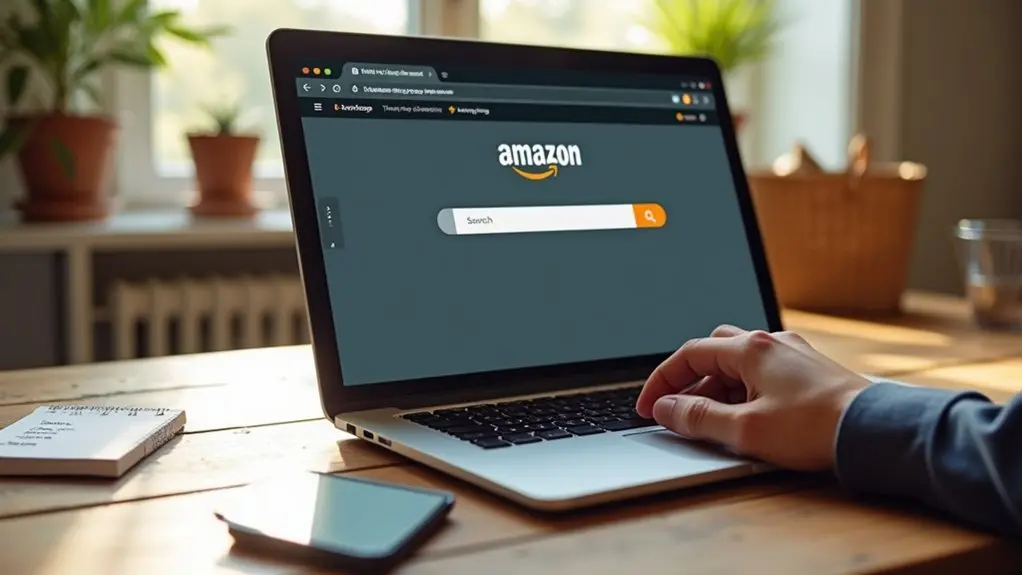Amazon Store is a extensive online marketplace where over 300 million active users access products offered by both Amazon and third-party sellers. Sellers utilize customized branded storefronts, advanced analytics, and advertising tools to enhance product visibility and sales. Amazon offers logistical options like Fulfillment by Amazon (FBA) and Fulfillment by Merchant (FBM), with associated referral and service fees impacting profitability. The Amazon Store’s evolving model and future trends continue to shape the global e-commerce environment, with further insights ahead.
Key Takeaways
- Amazon Store is a branded storefront that allows sellers to showcase their products with customized layouts and multimedia content.
- The online marketplace connects millions of buyers and sellers, providing tools for inventory management, analytics, and advertising.
- Sellers can choose Fulfillment by Amazon (FBA) for streamlined logistics or Fulfillment by Merchant (FBM) for more control over shipping.
- Selling on Amazon involves various fees, including referral, fulfillment, storage, and subscription charges depending on seller type and product category.
- Amazon emphasizes customer trust through quality assurance, dispute resolution policies, and continuous improvements in seller vetting and logistics.
Understanding the Amazon Store Model
While e-commerce continues to evolve, the Amazon Store model stands out as a strategic tool for brands aiming to maximize visibility and customer engagement within a highly competitive marketplace.
The Amazon Store provides sellers with a branded storefront, utilizing a customized layout to effectively showcase products and differentiate offerings. By integrating multimedia content—such as images, videos, and curated product collections—brands can present a richer narrative and engage a vast potential audience.
This seamless shopping experience, conducted entirely within the Amazon platform, capitalizes on consumer trust and simplifies the path to purchase. Additionally, the ability to link advertising campaigns directly to the Amazon Store empowers brands to drive traffic more efficiently, optimizing conversion rates and capturing a share of Amazon’s 300 million-plus active customer accounts.
Key Features of Amazon’s Online Marketplace
Amazon’s online marketplace is characterized by its expansive reach and multifaceted infrastructure, enabling third-party sellers to list products alongside Amazon’s own offerings and access a customer base exceeding 300 million active users. Amazon Marketplace provides robust tools for inventory management, sales analytics, and advertising services, such as Sponsored Products, to maximize product visibility. Third-party sellers can leverage Fulfillment by Amazon (FBA) for streamlined logistics or manage their own fulfillment, all while reaching millions of customers worldwide. Pricing strategies must account for referral fees, which vary by category and can greatly impact margins. The online platform supports a broad spectrum of products, driving substantial revenue growth.
| Feature | Benefit for Sellers | Impact on Market |
|---|---|---|
| FBA | Streamlined fulfillment | Higher efficiency |
| Advertising Services | Enhanced product visibility | Increased sales |
| Sales Analytics | Data-driven insights | Better strategies |
| Inventory Management | Stock control | Fewer stockouts |
| Referral Fees | Transparent costs | Margin calculation |
Seller Paths: FBA vs. FBM Explained
Among the key decisions facing sellers on the marketplace is choosing between Fulfillment by Amazon (FBA) and Fulfillment by Merchant (FBM), two distinct models that directly impact operational efficiency, cost structure, and sales potential.
FBA enables sellers to leverage Amazon’s fulfillment centers for inventory management, packing, shipping, and customer service, often resulting in Prime eligibility and increased sales. However, this model incurs additional fulfillment and storage fees, alongside standard referral fees.
FBA gives sellers access to Amazon’s fulfillment network and Prime benefits, boosting sales but adding extra fees to the cost structure.
In contrast, FBM requires sellers to manage their own logistics, offering more control but demanding greater operational effort and responsibility for shipping and customer service. FBM sellers avoid storage fees but still pay referral fees and shipping costs.
Data from 2020 indicates that FBA drives significant Amazon Marketplace growth, reflecting its popularity among third-party sellers.
Steps to Start Selling on Amazon
Entering the Amazon marketplace requires a structured approach, beginning with the creation of a seller account through Amazon Seller Central. During registration, sellers must provide business details, complete a tax interview, and set up payment by submitting bank and credit card information.
Selection between Individual and Professional plans will determine whether a monthly subscription fee or a per-item fee applies. Next, sellers create and optimize product listings with relevant keywords, high-resolution images, and thorough descriptions to enhance product visibility.
Choosing between Fulfillment by Amazon and self-managed logistics (FBM) impacts operational efficiency. Continuous use of analytics tools is essential for monitoring inventory levels, analyzing sales trends, and responding to customer feedback.
These data-driven steps are fundamental for successfully selling on Amazon Marketplace and achieving sustainable growth.
Fees and Costs Associated With Selling
After establishing an Amazon seller account and optimizing product listings, sellers must evaluate the various fees and costs that impact profitability on the platform.
Amazon charges referral fees on each sale, ranging from 6% to 45% depending on product category and selling plan. For sellers utilizing Fulfillment by Amazon (FBA), additional fees apply, including fulfillment fees based on item size and weight, as well as monthly storage fees for inventory housed in Amazon’s warehouses.
Individual sellers incur a $0.99 fee per item sold, whereas Professional sellers pay a monthly subscription fee, removing the per-item charge.
Sellers must consider variable closing fees, which can fluctuate by category and selling method. Regular review of fee statements is critical to monitor all costs and guarantee sustained profitability on the Amazon Marketplace.
Strategies for Success on Amazon Marketplace
While the competitive environment of Amazon Marketplace presents challenges, data-driven strategies remain essential for achieving sustained success. Sellers increase their advantage through utilizing competitive pricing strategies and optimizing product listings with high-quality images and detailed descriptions, directly enhancing product visibility. Utilizing Amazon’s advertising tools, such as Sponsored Products, further boosts traffic and conversion rates. Consistent delivery of excellent customer service is necessary to cultivate positive customer feedback, which, in turn, improves search ranking and buyer trust. Monitoring sales performance and analyzing customer behavior enable sellers to refine strategies and capitalize on market trends.
| Strategy | Impact |
|---|---|
| Competitive Pricing Strategies | Drives conversions, attracts buyers |
| Amazon’s Advertising Tools | Increases product visibility, traffic |
| Promotional Tactics (Digital Coupons) | Boosts sales performance, entices customers |
Addressing Challenges and Criticism
Amazon faces increasing scrutiny over legal liability, particularly following a U.S. appeals court decision that holds the company accountable for third-party seller products.
At the same time, many sellers report dissatisfaction with Amazon’s dispute resolution policies, citing ambiguity and heightened business risks.
These issues underscore the need for clearer governance and robust risk management strategies within the platform.
Legal Liability Concerns
Although e-commerce platforms have historically distanced themselves from liability for third-party sales, a pivotal U.S. appeals court ruling has established that Amazon can be held accountable for products sold by external vendors.
This legal liability shift considerably raises consumer protection and product safety standards within the Amazon marketplace. Persistent customer support complaints regarding third-party sellers have impacted Amazon’s reputation, contributing to a B rating from the Better Business Bureau as of January 2024.
In response, Amazon has tightened seller vetting processes to mitigate product liability claims and reinforce customer trust. Ongoing legal cases, such as FTC v. Amazon, underscore the dynamic regulatory environment.
Additionally, ambiguity in Amazon’s dispute resolution procedures has drawn criticism, influencing sellers’ risk perceptions and operational strategies in an evolving e-commerce atmosphere.
Seller Dispute Policies
Seller dispute resolution remains a critical pressure point within Amazon’s marketplace operations, as policies have drawn scrutiny for their ambiguity and inconsistency.
Recent legal developments, such as the 3rd U.S. Circuit Court of Appeals ruling, have intensified scrutiny of Amazon’s liability in relation to third-party sellers.
The A-to-Z Guarantee, a cornerstone of Amazon’s dispute resolution process, is designed to address customer complaints, yet sellers often cite issues surrounding dispute handling and perceived ineffectiveness.
Criticism has also focused on the need for improved product quality assurance and transparent seller policies.
In response, Amazon has implemented enhanced seller vetting to bolster customer trust and safety.
- Ambiguity in seller dispute resolution policies
- Increased disputes due to expanded legal liability
- Challenges reported with A-to-Z Guarantee resolution
- Calls for stronger product quality assurance
- Enhanced seller vetting to protect customer trust
The Future of Amazon’s Marketplace
As e-commerce evolves, the future of Amazon’s Marketplace is poised for substantial expansion, underpinned by third-party sellers who are projected to sustain over 54% of total sales. Amazon is expected to advance Fulfillment by Amazon (FBA) and logistics management, streamlining operations for sellers and enhancing the customer experience. Data analytics and AI will drive improvements in product visibility and personalized recommendations, optimizing both search relevance and conversion rates. In addition, Amazon’s ongoing global expansion will open new markets and require adaptation to local demands. Innovative advertising solutions are likely to become more sophisticated, supporting sellers in a competitive environment.
| Focus Area | Current Trend | Future Direction |
|---|---|---|
| Third-party sellers | 54%+ of total sales | Further revenue reliance |
| Fulfillment (FBA) | Expanded services | Enhanced logistics |
| Data & Advertising | A9 algorithm, ad solutions | AI-driven personalization |
Frequently Asked Questions
What Is the Amazon Marketplace Overview?
The Amazon Marketplace overview highlights seller benefits such as flexible product listing, diverse shipping options, multiple payment methods, and robust inventory management. Sellers leverage advertising tools, analyze customer reviews, evaluate seller fees, and monitor market trends and competitor analysis for optimization.
What Is the Basic Overview of Amazon?
A basic overview of Amazon highlights its dominance in e-commerce trends, utilizing advanced digital marketing, optimized product listings, innovative seller strategies, diverse fulfillment options, dynamic pricing models, efficient inventory management, and robust shipping logistics to enhance online shopping and customer experience.
What Is an Amazon Marketplace Store?
An Amazon Marketplace Store enables sellers to leverage Amazon Storefront Features, streamline Seller Registration Process, manage Marketplace Fees Structure, optimize Product Listing Strategies, prioritize Customer Review Importance, evaluate Fulfillment Options Comparison, utilize Advertising on Amazon, access Seller Support Resources, and apply Marketplace Analytics Tools for Competition Analysis Strategies.
What’s the Difference Between Amazon and Amazon Marketplace?
Amazon operates as a direct retailer, controlling product listings, fulfillment services, and customer reviews, while Amazon Marketplace enables third-party sellers to manage inventory, compete on seller fees, leverage advertising tools, utilize diverse shipping options, and access robust sales analytics.
Conclusion
Amazon’s online marketplace remains a dominant force, accounting for over 37% of U.S. e-commerce sales in 2023. Its dual FBA and FBM models offer diverse entry points for sellers, though competition and fees are significant factors. Success relies on strategic optimization, data analysis, and adaptation to evolving marketplace trends. As Amazon continues expanding its technological and logistical capabilities, it is poised to shape the future of digital retail, presenting both opportunities and challenges for sellers worldwide.




